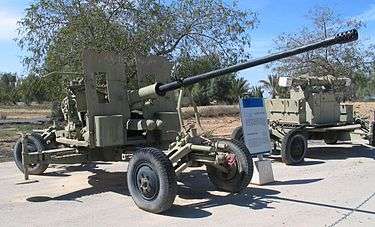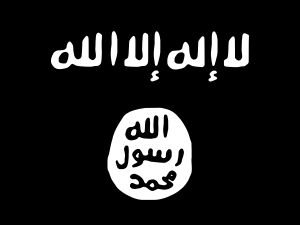AZP S-60
57 mm AZP S-60 (Russian: Автоматическая зенитная пушка С-60, abbrev. АЗП (AZP); literally: Automatic anti-aircraft gun S-60) is a Soviet towed, road-transportable, short- to medium-range, single-barrel anti-aircraft gun from the 1950s. The gun was extensively used in Warsaw Pact, Middle Eastern and South-East Asian countries.
| 57 mm AZP S-60 | |
|---|---|
 S-60 in an Israeli museum | |
| Type | Autocannon |
| Place of origin | Soviet Union |
| Service history | |
| In service | 1950–present |
| Used by | See users |
| Wars | Vietnam War Laotian Civil War Cambodian Civil War Cambodian–Vietnamese War Lebanese Civil War Iran–Iraq War Gulf War Somali Civil War Iraq War Syrian Civil War[1] Iraqi Civil War (2014–2017) Yemeni Civil War (2015–present) Saudi Arabian-led intervention in Yemen numerous others |
| Production history | |
| Designer | Vasiliy Gavrilovich Grabin |
| Manufacturer | TsAKB |
| Specifications | |
| Mass | 4,660 kg (10,273 lbs) |
| Length | 8.5 m (27 ft 11 in) |
| Barrel length | 4.4 m (14 ft 5 in)[2] |
| Width | 2.054 m (6 ft 9 in) |
| Height | 2.37 m (7 ft 9 in) |
| Crew | 7 |
| Shell | Fixed QF 57×348mmSR |
| Caliber | 57mm (2.24 in) |
| Action | Recoil operated |
| Carriage | Four wheels with outriggers |
| Elevation | −4° to +85° |
| Traverse | 360°[2] |
| Rate of fire | 105–120 rpm (cyclic) 70 rpm (sustained) |
| Muzzle velocity | 1,000 m/s (3,281 ft/s) |
| Effective firing range | 6,000 m (20,000 ft) (radar guided) 4,000 m (13,000 ft) (optically guided) |
History
In the late 1940s, the Soviets started to develop a 57 mm anti-aircraft gun, to replace its 37 mm guns. Three different models were presented, and the winning design was made by V. G. Grabin. According to western intelligence sources, the German prototype gun 5,5 cm Gerät 58 formed the basis for the design. The Soviets were also able to study German 5 cm Flak 41 guns that had been captured following the Battle of Stalingrad.
The prototype passed the field tests in 1946 and was accepted into service in 1950, after some minor modifications. The anti-aircraft gun was given the name 57 mm AZP S-60. Grabin continued the development and fielded the SPAAG version ZSU-57-2 in 1955.
The fire direction device was developed from the German Lambda calculator (Kommandogerät 40, 40A, and 40B) and was called PUAZO-5A. It had also a distance measuring device called D-49. The fire direction was also made more effective by including Grom-2 (10 cm wavelength) radars to the AA-batteries. The whole system was called SON-9. Later on, the calculators would be changed into the more modern RPK-1 Vaza, which had been designed by M. M. Kositskin. The calculator and the radars were transported by Ural 375 trucks.
The 57 mm gun replaced the 37 mm divisional guns in Soviet service in the 1950s. A divisional anti-aircraft regiment consisted of two AA-batteries with six 57 mm guns each. The PVO air-defence troops AA-regiments consisted of four 57 mm AA-batteries (24 guns).
In the mid-1960s, the Soviet divisional anti-aircraft units began replacing their AA-guns with missiles, and by the end of the 1970s, the AA-guns had almost disappeared. However, they were used in many other countries. The performance of AAA in Vietnam against low-flying aircraft led the Soviets to bring back many guns from storage to supplement the Surface-to-Air Missiles, whose performance at low altitude was less than satisfactory.
Operational history
The S-60 and its Chinese copy (the Type 59) have seen combat in several wars all over the world—e.g., the Six-Day War and the Yom Kippur War in the Middle East, and the Soviet–Afghan War. During the Vietnam War, the S-60 was the keystone of North Vietnamese low-altitude air defense and was most effective between 460 meters and 1,500 meters.
In Iraq (Iran–Iraq War, Gulf War and Iraq War), the S-60, normally deployed in battalions of 36 guns, served consistently in defense of divisional headquarters and field artillery assets.
Georgian army air defence units used S-60 guns during Russo-Georgian War war, some units engaged Russian attack aircraft near city of Gori. none were shot down by S-60 thought some were damaged.
Syrian S-60 guns were actively used during the Syrian Civil War by both the army and different rebel groups. As many other guns originally designed for antiaircraft use, most of the time they were used in shelling ground targets.[3]
The Islamic State allegedly shot down a Cessna 208 Caravan operated by the Iraqi Air Force near Hawija, Iraq on 16 March 2016 with a truck-mounted S-60.[4][5][6]
Ammunition types
The S-60 fires ammunition in 57×348SR caliber, with ballistics (see below) similar to the longer 57×438mm ammunition of Bofors 57 mm AA gun, but somewhat weaker than Soviet 57 mm anti-tank guns of World War II. Modern anti-aircraft rounds have not been developed for the gun; the main characteristics of the Soviet-era ammunition are listed in the table below. In addition to these People's Republic of China manufactures ammunition in 57x348SR caliber, designated Type 59 HE-T, Type 59 AP-T, and Type 76 HE-T.
Training rounds include a blank round MK-281 ("Manöver-Kartusche", East German designation), and training rounds with -IN suffix (UBR-281U-IN, UOR-281U-IN) identifying the rounds as fuzeless versions of the APCBC and HE rounds with dummy fuzes and inert filling replacing the explosive cavities.
| Designation | Type | Projectile weight [g] | Bursting charge [g] | Muzzle velocity [m/s] | Description |
|---|---|---|---|---|---|
| UBR-281/281U | APCBC-HE-T | 2,820[7] | 13[7] | 1,000[7] | Anti-tank round with sharp penetrator, blunt cap and an aerodynamic cover, with tracer and a delayed-action base fuze.[7] Penetration 96 mm RHA at 1,000 m range or 106 mm at 500 m.[8] UBR-281 and -281U are loaded with the same projectile and differ only by details in case mouth and swage grooves.[7] |
| UOR-281 | HE-T | 2,850[7] | 154[7] | 1,000[7] | Impact-fuzed fragmentation shell for anti-aircraft use. Nose fuze with self-destruct function and a tracer.[7] |
| UOR-281U | HE-T | 2,850[7] | 154[7] 168[8] |
1,000[7] | Similar to UOR-281; some sources state the shell is the same as in UOR-281 and the round differs from it only in details of the case mouth and swage grooves (as with the UBR round),[7] while others claim a slightly larger HE filling.[8] |
| 3UO6 | HE | ? | 154 | 1,000 | Similar to UOR-281U but with proximity fuze AR-51 installed. Fuze operating with RPK-1 system together. Not to be confused with later smart shells which Russia developed. |
| Type 59 AP | AP-T | ? | ? | ? | Chinese anti-tank round presumably similar to UBR-281/281U. |
| Type 59 HE | HE-T | ? | ? | ? | Chinese fragmentation round for anti-aircraft use, presumably similar to UOR-281/281U. |
| Type 76 HE | HE-T | ? | ? | ? | Chinese fragmentation round. |
Airburst munitions for Russian 30 mm and 57 mm autocannons are in development.[9][10][11][12]
Versions
- AK-725: Naval version of the S-60 gun. Introduced in 1958. Mounted in single, double and quadruple mounts (designated ZIF-31) on many early Soviet destroyers.
- ZIF-72: Naval version which is enclosed in a metal housing and fully automatic. Also exported to India. Introduced in the mid-1970s.
- ZSU-57-2: Self-propelled version with two 57 mm S-60 guns (designated S-68)
- Type-80: Chinese version of the ZSU-57-2.
- BM-57: Updated version.
- AU-220M Baikal: Remote weapon station with fire control system using BM-57.[13]
Users
The S-60 was sold to at least 37 different countries during the Soviet era. The gun was also license manufactured in Poland by Zakłady Mechaniczne Tarnów in Tarnów (en. Tarnów Mechanical Works), and in Hungary by DIMÁVAG in Miskolc-Diósgyőr, and in China as the Type 59.
Current operators





























.svg.png)




Former operators






















%3B_Flag_of_Serbia_and_Montenegro_(2003%E2%80%932006).svg.png)

References
- "YouTube". Youtube.com.
- Foss, Christopher (1977). Jane's Pocket Book of Towed Artillery. New York: Collier. p. 243. ISBN 0020806000. OCLC 911907988.
- "YouTube". Youtube.com.
- "Archived copy". Archived from the original on 2 April 2016. Retrieved 3 April 2016.CS1 maint: archived copy as title (link)
- Kaplan, Michael (16 March 2016). "Did ISIS Shoot Down Iraqi Military Plane? Islamic State Group Claims Anti-Aircraft Attack In Hawija". International Business Times.
- Ranter, Harro. "ASN Aircraft accident Cessna AC-208B Combat Caravan YI-119 Hawijah". Aviation-safety.net.
- "The Russian Ammunition Page - Home". Russianammo.org.
- Jane's Ammunition Handbook, 1994
- "Cloud from shrapnel: how controlled ammunition will strengthen the power of Russian armored vehicles – International News". Tellerreport.com. Retrieved 19 July 2019.
- "Russia's Military Built a 'Terminator' And Now It's Getting Smart Weapons". Newsweek.
- "TASS: Military & Defense – Russia to develop anti-drone shrapnel ammunition". Tass.com. Retrieved 19 July 2019.
- "UVZ to unveil modernized BMP-1 with 2A72 cannon at Army 2018". Armyrecognition.com.
- "JSC CRI "Burevestnik"/ 57mm AU220M Automatic Weapon Station". Burevestnik.com.
- The Military Balance 2017, p. 274.
- doanhnghiepvn.vn. "Báo Nga bình luận về pháo phòng không S-60 AZP Việt Nam tự nâng cấp - Doanh nghiệp Việt Nam". Cơ quan ngôn luận của hiệp hội doanh nghiệp nhỏ và vừa Việt Nam (in Vietnamese). Retrieved 12 June 2020.
- http://spioenkop.blogspot.com/2014/11/vehicles-and-equipment-captured-and.html
- Ross, Russell, ed. (1987). Cambodia, a Country Study. Area Handbook Series (Third ed.). Washington, D.C.: Department of the Army, American University. p. 313. ISBN 978-0160208386.
Bibliography
- Koll, Christian (2009). Soviet Cannon - A Comprehensive Study of Soviet Arms and Ammunition in Calibres 12.7mm to 57mm. Austria: Koll. p. 467. ISBN 978-3-200-01445-9.
External links
| Wikimedia Commons has media related to S-60 57 mm gun. |